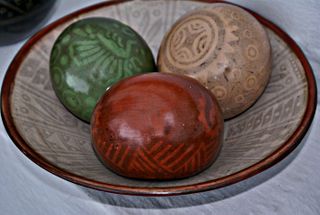
Esferas de barro y su platón (clay spheres and their platter) from Zinapécuaro, Michoacán. Feria de Artesanía, Pátzcuaro 2009.
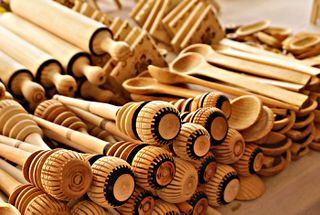
Carved wooden molinillos (chocolate beaters), rolling pins, and spoons from Quiroga, Michoacán.
The state of
Michoacán, rich in clay, copper, wood, and other natural resources, is
home to thousands of highly skilled artisans. Their traditional work
includes the use of all of those natural materials. Each year during
Pátzcuaro's festivities for the Day of the Dead, an all-Michoacán
artisans' fair entices tourists from all over Mexico (as well as from
the rest of the world) to support the local crafts-making economy.
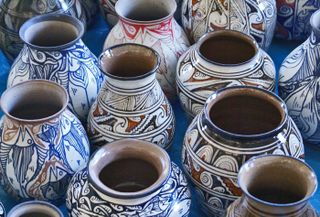
Floreros de barro (clay vases) from Tzintzuntzan, Michoacán.
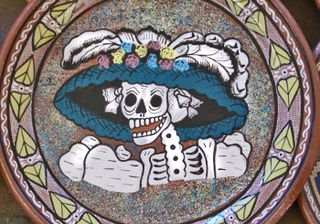
La Huesuda (the bony woman) on a platter, Capula, Michoacán. La Huesuda is among the many, many Mexican terms for death.
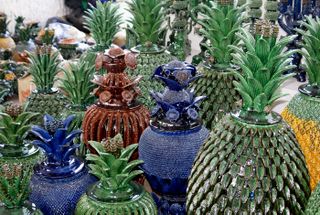
Piñas (pineapples) from San José de Gracia, Michoacán. These were originally made to be containers for serving agua fresca (fruit water).
The November artisans' fair in Pátzcuaro and the larger
all-Michoacán artisans' fair in Uruapan that takes place annually from Palm Sunday through
the end of Easter Week are the biggest income-producing events for many
of the state's artisans. Due in part
to the global economic crisis, in part to fear of the AH1N1 virus, and
in part to reported drug-related violence in Mexico, tourism all over the country has fallen to record
low levels. During 2009, most Michoacán artisans have experienced a precipitous
drop in sales.

Comedor (dining room table and chairs), Cuanajo, Michoacán.
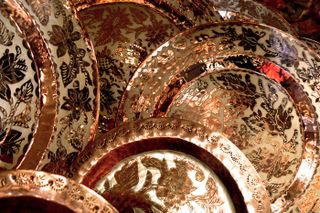
Highly decorated platones de cobre (copper platters) from Santa Clara del Cobre, Michoacán. Photo courtesy of this Flickr user.
Michoacan's artisans work using centuries-old techniques to create both traditional and modern designs. Among village families, skills are passed from generation to generation. It's unusual to find an artisan who has formally studied his or her art, but it is far from unusual to find enormously talented artists, even in the smallest towns.
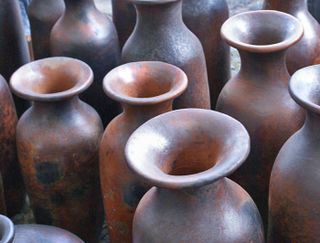
Cocuchas (pots from the tiny Purhépecha town of Cocucho), Cocucho, Michoacán.
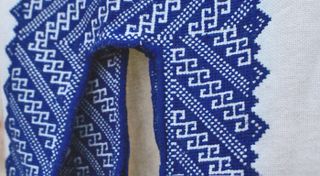
Detail of cross-stitch blouse, Pátzcuaro, Michoacán.

Figuras de barro (clay figures), Ocumicho, Michoacán.
Many artisan families are currently confronting the tension between the desire to continue to produce arts and crafts and the overwhelming need to feed their children. In an economy geared toward the purchase of necessities, not luxuries, the purchase of personal and home adornment comes last for the average tourist. Although sales were up somewhat at the 2009 Pátzcuaro artisans' fair, in general sales for 2009 have been very low.
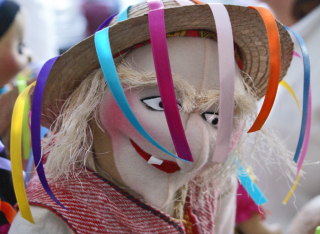
Viejito de trapo (Dance of the Viejitos rag doll).
In many
instances, young artisans have left their family's traditional work
altogether to seek employment in other sectors. Thousands of young men
have left Michoacán to try their luck in the United States. Hands that
once worked clay, copper, wood, and reed now wash dishes, bus tables,
and pick crops far from home. The questions that plague the artisans
who remain in Michoacán are: who will keep the traditions alive? Who
will continue the work of centuries? Do today's young people care if
the old ways die out?
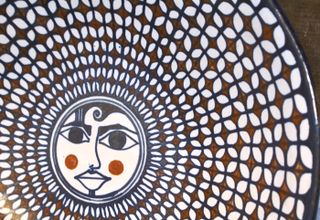
Platón (platter), Guadalupe Ríos, Tzintzuntzan, Michoacán.
Some municipalities, such as the copper arts-producing town of Santa Clara del
Cobre, the pine needle arts-producing town of Casas Blancas, and the rag doll producing town of Zirahuén, are working together to find a solution to the artisans' need
for support. In Santa Clara, nearly 90% of the town is employed in the copper industry. Municipal authorities recognize that artisan productivity is vital to the town. The town governments have proposed a grant of two thousand pesos (approximately $155 USD at today's exchange rate) each to 35 needy artisans for the purchase of necessary materials to continue working in their traditional fields. The sole requirement for participating in the grant program is that the recipients document how the money is spent and how many people are either direct or indirect beneficiaries of the program. Of course, one very small municipality's tiny stimulus program will not save all of
Michoacán's artisans, but it may help stave off their need to stop
production. The larger question is whether this generation and those to come recognize the value of their historic work. That remains to be answered.

Vajilla (dishware), Capula, Michoacán.
Looking for a tailored-to-your-interests specialized tour in Mexico? Click here: Tours
Leave a Reply to maria v Cancel reply